January is All Asia All Month on LunaCafe. But I eat this spicy Korean soup all year long.
There was a time in my life that it was not unusual for me to take in three movies in one evening. I timed the showings in advance, so I could race from one Seattle movie house to another and slip into a chair just as the previews were ending. If the timing was perfect, I scored an espresso between shows. I can still remember one memorable, caffeine-charged evening when I saw Betrayal, The Grey Fox, and Victor/Victoria back-to-back. All three films were great. I practically floated home.
And as I discovered during this movie crazed period, some of the most memorable movies are subtitled. A Man and A Woman, The Last Emperor, and Cinema Paradiso come to mind. Subtitles are no barrier for this movie addict.
Thus, with the advent and ease of Netflix, it was inevitable that I would eventually stumble upon Korean dramas. I’ve watched Pasta (twice), Stars Falling from the Sky, Midas, Shining Inheritance, Bread, Love and Dreams, Secret Garden, Full House, Flower Boy Ramen Shop, and dozens of others that have slipped from memory. My favorites center on honoring and sharing food (naturally).
And do you know the one thing that all of these well-crafted, food-centered, serial dramas have in common? Noodles! Bowl after bowl of steaming Spicy Korean Noodle Soup to be precise.
People in Korea, as depicted in these dramas at least, eat ramen from morning to night. They eat it when they’re happy. They eat it when they’re sad. They eat it to celebrate, commemorate, commiserate, and mourn.
And it looks so incredibly GOOD. The broth is sometimes thin and sometimes thick, always with a reddish hue. It’s steaming hot and the noodles are usually fresh. The things that go into and on top of the soup vary from cook to cook. There are contests to see who can come up with the best new ramen bowl. Seafood is often part of the mix though. And a poached egg poised like a buoyant hat on top.
Trust me–you’ll be drooling before the hour-long episode ends. You might even be tempted to replay the soup scenes.
Out of desperation, I recently bought a case of dried ramen cups from Costco—just to have something to slurp while watching the gorgeous Korean actors eat the real thing.
But enough of that nonsense. It’s high time to cross the ramen barrier and learn to make my own Spicy Korean Noodle Soup, or Jjambbong as it’s called in Korea. Luckily, it couldn’t be easier—but does entail a trip to your local Asian supermarket for a few of the essential ingredients.
If you’re in Portland, Oregon, head over to Fubonn Market and pick up Korean fermented hot pepper paste, fresh Korean jjang noodles, fresh ginger, garlic, Chinese chives, baby bok choy, lemon, fresh prawns, and perhaps Korean coarse red pepper flakes. You probably have Kikkoman soy sauce, but if not, pick that up too.
Spicy Korean Noodle Soup (Jjambbong)
This spicy, red-hued, infinitely variable, magically comforting noodle soup is one of the most popular Korean dishes. It’s great with prawns and other seafood, but also delicious with vegetables only. The soup broth is clean and bright, and only moderately spicy as prepared here.
You’ll find Korean soup noodles, labeled Korean, somen, or jjang noodles, in the fresh noodle section of your local Asian supermarket. They’re typically about 1/8-inch in diameter and comprised of only wheat flour, salt, and water. In Portland, Oregon. Fubonn Supermarket and the Beaverton Uwajimaya are reliable sources for these noodles.
Note If you make Korean Spicy Pepper Sauce and do the minimal ingredient prep ahead, the soup will go together in only a few minutes.
Korean Spicy Pepper Sauce (makes about ¾ cup)
½ cup Korean fermented hot pepper paste (Wang brand is good)
2 tablespoons Kikkoman soy sauce
2 tablespoons freshly squeezed lemon juice
2 tablespoons golden brown sugar
2 tablespoons peeled, minced garlic
2 tablespoons peeled, minced fresh ginger
Noodles
10-12 ounces fresh Korean jjang noodles (from Wang 2.2-pound package)
cold water
2 teaspoons fine sea salt
Aromatics
1 tablespoon vegetable oil
¼ yellow onion, thinly sliced
2 tablespoons minced Chinese chives (garlic chives/kow choi/nira), or green onions)
Veggies & Prawns
2 green onions, trimmed, cut into 2-inch lengths
1 large carrot, peeled, halved lengthwise, cut into 2-inch lengths, thinly sliced lengthwise
10 peeled, deveined, fresh, medium prawns, optional (I leave the tails on)
4 baby bok choy, stems trimmed, large leaves halved lengthwise
Sauce & Stock
¼ cup Korean Spicy sauce (from above)
4 cups homemade or canned chicken stock, heated to a simmer
Garnish
Chinese chives, (garlic chives/kow choi/nira), or green onions
Korean coarse red pepper powder/flakes, optional (kochugaru)
- Prepare the sauce. In a medium mixing bowl, combine hot pepper paste, soy sauce, brown sugar, lemon juice, garlic, and ginger. Reserve. (You’ll use ¼ cup here and have ½ cup remaining for later use.)
- Cook the noodles. Fill a large pasta pot with a perforated insert with cold water, add salt, and bring to a full boil. When soup base is 2 minutes from completion, add noodles to boiling water and boil for 1½- 2 minutes, no longer. Lift perforated insert from pasta pan to drain water, and then, with a pronged pasta fork, divide noodles between two soup bowls.
- Complete the stir-fry. In a flat-bottomed, heavy wok or large heavy skillet, heat oil to sizzling. Add onions and Chinese chives. Toss to coat with oil, and fry for 1 minute. Add carrots, toss to coat, and stir-fry for 1 minute.
- If using, add prawns to stir-fry, toss to coat, and stir-fry for 1 minute, until they begin to turn pink.
- Add ¼ cup sauce, and toss to coat the aromatics. Add bok choy. Stir to combine.
- Complete the soup. Pour stock over noodles in bowls and arrange veggies and prawns on top.
- Garnish with Chinese chives and pepper powder, if desired.
- Serve immediately. Noodles become spongy (or bloated, as Koreans describe it) if left to sit in hot stock for any length of time.
Serves 2.
Cookin’ with Gas (inspiration from around the web)
- Amazon: The Korean Table: From Barbecue to Bibmbap
- AmbitiousDelicious:JJampong (Korean Spicy Seafood Noodle Soup)
- Jeanette’s Healthy Living: Spicy Korean “Ramen” Noodle Soup
- Kimchi Mom: Spicy Seafood Noodle Soup (Jjamppong) (gorgeous photo)
- Korean Bapsang: Janchi Guksu (Korean Warm Noodle Soup)
- Korean Bapsang: Jjambbong (Korean-Chinese Spicy Noodle Soup)
- Maangchi: Sujebi (Hand Torn Noodle Soup)
- New Asian Cuisine: Seasoned Red Pepper Paste
- The Daily Meal: Jjambbong (Korean-Chinese Spicy Noodle Soup)
- ZenKimchi Korean Food Journal: Eun Jeong’s Noodle Soup (Janchi Guksu)
Copyright 2012-2017 Susan S. Bradley. All rights reserved.

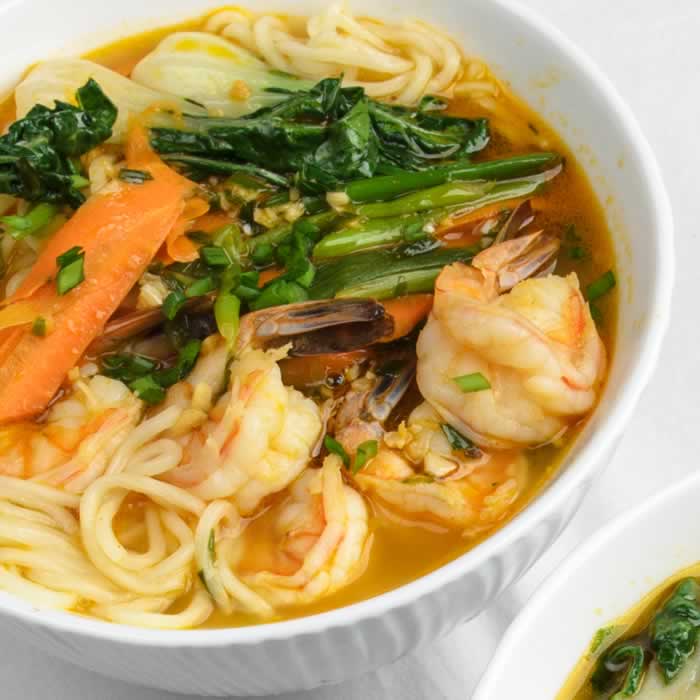
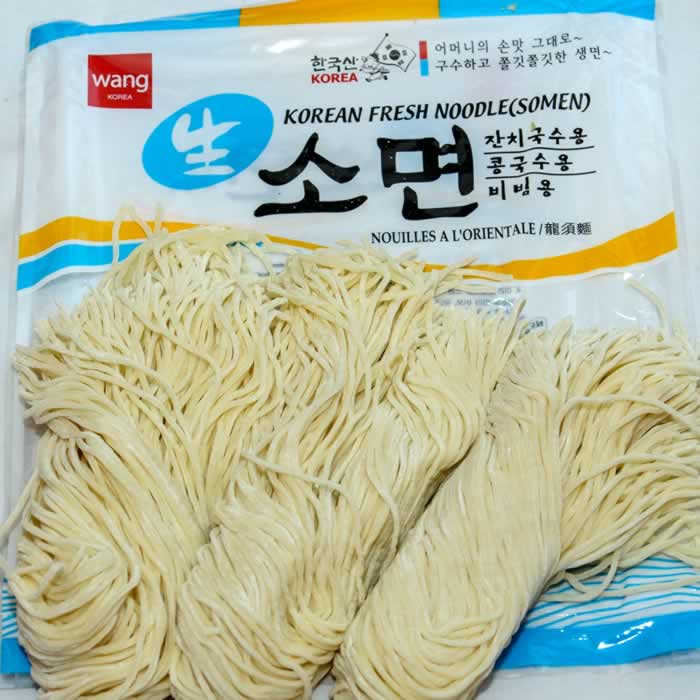

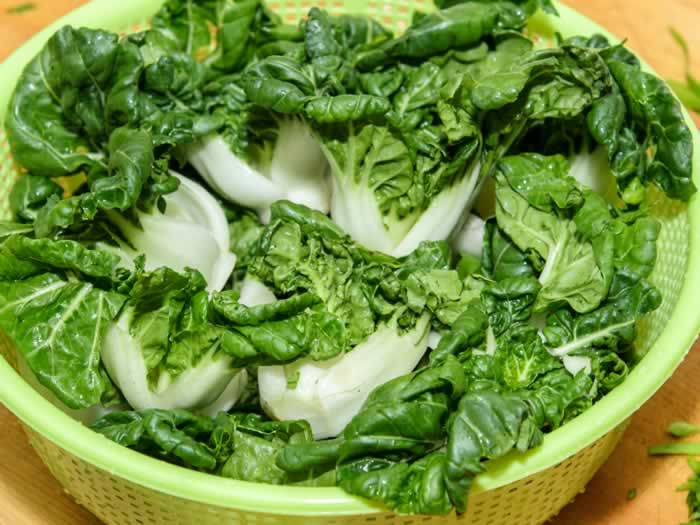

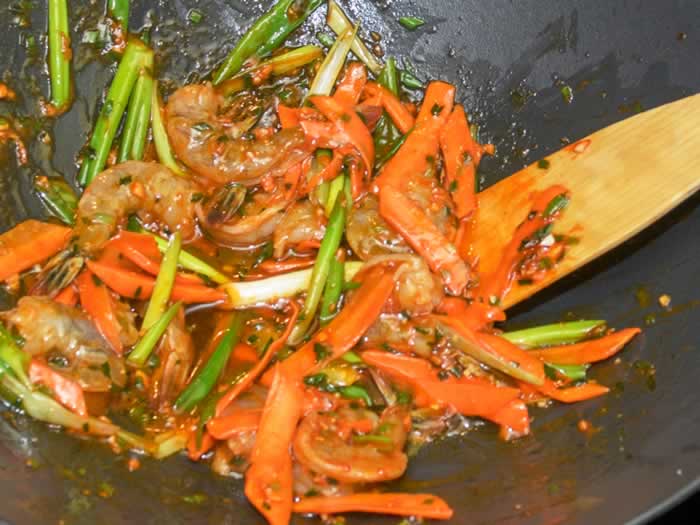
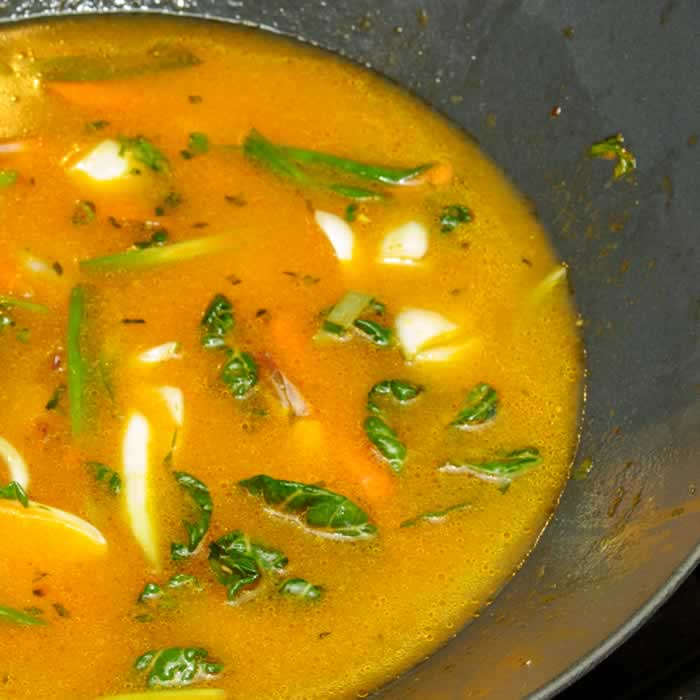
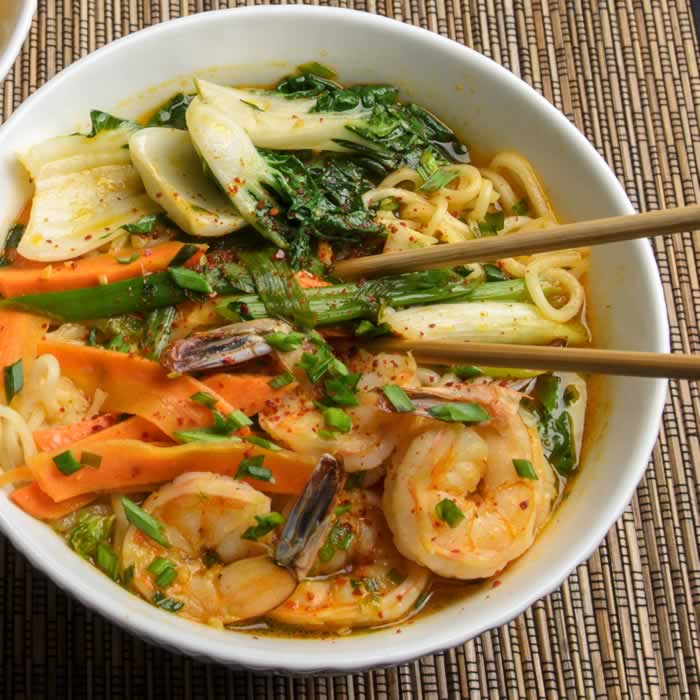
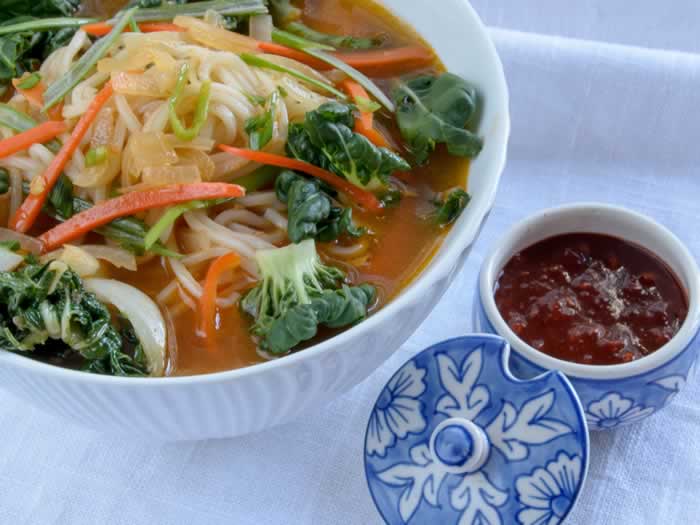
this sounds good. Something new to try as well. thanks for sharing this recipe.
Simon
Simon, you’re going to love it.
Alicia, LOL! I’m watching a K-drama now in which they show the production of rice cakes. There are so many scenes of people eating these glutinous looking sticks in some sort of spicy sauce that I think it’s a conspiracy to get us all to try them. Today I am driving to the nearest Asian market to get a package.